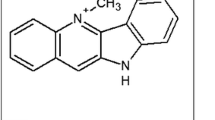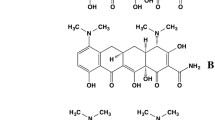Abstract
Antimalarial interventions mostly rely upon drugs, as chloroquine. However, plasmodial strains resistant to many drugs are constantly reported, leading to an expansion of malaria cases. Novel approaches are required to circumvent the drug resistance issue. Here, we describe the antimalarial potential of the chloroquine analogue 2-[[2-[(7-chloro-4-quinolinyl)amino]ethyl]amino] ethanol (PQUI08001/06). We observed that PQUI08001/06 treatment reduces parasitemia of both chloroquine-resistant and -sensitive strains of Plasmodium falciparum in vitro and P. berghei in vivo. Our data suggests that PQUI08001/06 is a potential antimalarial therapeutic alternative approach that could also target chloroquine-resistant plasmodial strains.



Similar content being viewed by others
References
Antony HA, Parija SC (2016) Antimalarial drug resistance: an overview. Trop Parasitol 6:30–41. https://doi.org/10.4103/2229-5070.175081
Beteck RM, Smit FJ, Haynes RK, N’Da DD (2014) Recent progress in the development of anti-malarial quinolones. Malar J 13:339. https://doi.org/10.1186/1475-2875-13-339
Duraisingh MT, Cowman AF (2005) Contribution of the pfmdr1 gene to antimalarial drug-resistance. Acta Trop 94:181–190. https://doi.org/10.1016/j.actatropica.2005.04.008
Egan TJ, Ncokazi KK (2005) Quinoline antimalarials decrease the rate of beta-hematin formation. J Inorg Biochem 99:1532–1539. https://doi.org/10.1016/j.jinorgbio.2005.04.013
Fidock DA, Nomura T, Talley AK, Cooper RA, Dzekunov SM, Ferdig MT, Ursos LMB, bir Singh Sidhu A, Naudé B, Deitsch KW, Su XZ, Wootton JC, Roepe PD, Wellems TE (2000) Mutations in the P. falciparum digestive vacuole transmembrane protein PfCRT and evidence for their role in chloroquine resistance. Mol Cell 6:861–871
Ibraheem ZO, Abd Majid R, Noor SM, Sedik HM, Basir R (2014) Role of different Pfcrt and Pfmdr-1 mutations in conferring Resistanparasce to Antimalaria drugs in Plasmodium falciparum. Malar Res Treat 2014:950424. https://doi.org/10.1155/2014/950424
Kaiser CR, Pais KC, de Souza MVN, Wardell JL, Wardell SMSV, Tiekink ERT (2009) Assessing the persistence of the N–H⋯N hydrogen bonding leading to supramolecular chains in molecules related to the anti-malarial drug, chloroquine. CrystEngComm 11:1133–1140. https://doi.org/10.1039/b823058g
Knight DJ, Peters W (1980) The antimalarial activity of N-benzyloxydihydrotriazines. I. The activity of clociguanil (BRL 50216) against rodent malaria, and studies on its mode of action. Ann Trop Med Parasitol 74:393–404
Krafts K, Hempelmann E, Skórska-Stania A (2012) From methylene blue to chloroquine: a brief review of the development of an antimalarial therapy. Parasitol Res 111:1–6. https://doi.org/10.1007/s00436-012-2886-x
Lambros C, Vanderberg JP (1979) Synchronization of Plasmodium falciparum erythrocytic stages in culture. J Parasitol 65:418–420
Martin RE, Marchetti RV, Cowan AI, Howitt SM, Broer S, Kirk K (2009) Chloroquine transport via the malaria parasite’s chloroquine resistance transporter. Science 325:1680–1682. https://doi.org/10.1126/science.1175667
Peters W (1968) The chemotherapy of rodent malaria. V. Dynamics of drug resistance. I. Methods for studying the acquisition and loss of resistance to chloroquine by Plasmodiun berghei. Ann Trop Med Parasitol 62:277–287
Picot S, Olliaro P, de Monbrison F, Bienvenu AL, Price RN, Ringwald P (2009) A systematic review and meta-analysis of evidence for correlation between molecular markers of parasite resistance and treatment outcome in falciparum malaria. Malar J 8:89. https://doi.org/10.1186/1475-2875-8-89
Platel DF, Mangou F, Tribouley-Duret J (1998) High-level chloroquine resistance of Plasmodium berghei is associated with multiple drug resistance and loss of reversal by calcium antagonists. Int J Parasitol 28:641–651
Ryley JF, Peters W (1970) The antimalarial activity of some quinolone esters. Ann Trop Med Parasitol 64:209–222
Smilkstein M, Sriwilaijaroen N, Kelly JX, Wilairat P, Riscoe M (2004) Simple and inexpensive fluorescence-based technique for high-throughput antimalarial drug screening. Antimicrob Agents Chemother 48:1803–1806
Su X, Kirkman LA, Fujioka H, Wellems TE (1997) Complex polymorphisms in an approximately 330 kDa protein are linked to chloroquine-resistant P. Falciparum in Southeast Asia and Africa. Cell 91:593–603
Trager W, Jensen JB (1976) Human malaria parasites in continuous culture. Science 193:673–675
White NJ, Pukrittayakamee S, Hien TT, Faiz MA, Mokuolu OA, Dondorp AM (2014) Malaria. Lancet 383:723–735. https://doi.org/10.1016/S0140-6736(13)60024-0
Woodrow CJ, Krishna S (2006) Antimalarial drugs: recent advances in molecular determinants of resistance and their clinical significance. Cell Mol Life Sci 63:1586–1596. https://doi.org/10.1007/s00018-006-6071-1
Acknowledgements
We thank the anonymous reviewers for their comments, suggestions, and input which rendered this work more accurate and accessible to the readers. We are grateful to Dr. Erika Martins Braga and Juliana Carvalho Tavares for kindly providing P. berghei strain NK65. The authors are grateful to Dr. Claudio Tadeu Daniel-Ribeiro for kindly providing the P. falciparum strains 3D7 (chloroquine-sensitive) and W2 (chloroquine-resistant).
Funding
We thank the following funding agencies for the financial support: CNPq, FAPERJ, PRONEX, PAPES, and Fondazione Ri.MED.
Author information
Authors and Affiliations
Corresponding author
Ethics declarations
Conflict of interests
The authors declare that they have no conflict of interest.
Additional information
Section Editor: Kevin S.W. Tan
Electronic supplementary material
Fig. S1
Synthetic route for preparation of PQUI08001/06. From 4,7-dichloroquinoline (left), the derivative 2-[(7-chloro-4-quinoliny)amino] ethanol (compound 1) which, per turn, originated the derivative N-(2-chloroethyl)-N-(7-chloro-4-quinolinyl) amine (compound 2). From the latter, PQUI08001/06 (right) was obtained. (PNG 67 kb)
Fig. S2
Survival curves analysis during P. berghei ANKA 4-day (A) showed a significant difference at chloroquine 25 mg/kg and Rane (established infection) test (B) showed significant difference among chloroquine and PQUI08001 25, 50 and 100 mg/kg in relation to vehicle group and no significant difference chloroquine and PQUI08001. Chloroquine and PQUI08001/06 concentrations are indicated in the graph. Curves were evaluated by Log-rank (Mantel-Cox) and Gehan-Breslow-Wilcoxon tests. * p < 0.05 or less in relation to vehicle group. (PPTX 61 kb)
Table S1
(DOCX 15 kb)
Table S2
(DOCX 12 kb)
Rights and permissions
About this article
Cite this article
Reis, P.A., Pais, K.C., Pereira, M.F. et al. In vivo and in vitro antimalarial effect and toxicological evaluation of the chloroquine analogue PQUI08001/06. Parasitol Res 117, 3585–3590 (2018). https://doi.org/10.1007/s00436-018-6057-6
Received:
Accepted:
Published:
Issue Date:
DOI: https://doi.org/10.1007/s00436-018-6057-6




